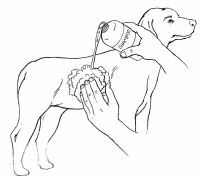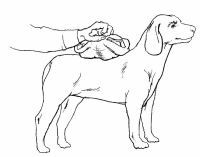How to Treat a Burned Dog
Dogs just love being underfoot while their owners are cooking. While this can be an admirable trait of man's best friend, it can also be dangerous when boiling water or hot cooking oil is being used in the kitchen.
A dog may experience first-, second-, or third-degree burns that are caused by fire, heat, boiling liquids, chemicals, and electricity. All are painful and can cause damage, even death. Superficial burns, evidenced by pain and reddening of the skin, are usually not serious. However, first aid should be given as soon as possible to ease the pain.
Advertisement
The following tips will help you not only identify the type of burn you're dealing with but will also give you suggestions on how to best treat the injury.
First- or Second-Degree Burns
The signs of a first-degree burn include fur intact or singed, painful lesions, or red skin with possible blisters. The signs of a second-degree burn are singed fur or painful lesions that turn tan in color with swelling and blisters. If you notice any of these warning signs, here's what to do:
Step 1: Restrain the dog if necessary.
.
Step 2: Apply cold water or ice packs to the burned area and leave in contact with the skin for 15 minutes. DO NOT apply ointment or butter.
Step 3: If burns cover a large part of the dog's body or are located where the dog can lick them, cover the area with a sterile dressing. DO NOT use cotton.
Step 4: Wrap torn rags or other soft material around the dressing and tie or tape it just tightly enough to keep it in place.
Step 5: Transport the dog to the veterinarian as soon as possible.
Third-Degree Burns
The signs of a third-degree burn include destruction on entire skin area, black or pure white lesions, or fur that pulls out easily. Also watch for signs of shock, which include pale or white gums, a rapid heartbeat, or rapid breathing. If you notice these signs, here's what to do:
Step 1: Restrain the dog if necessary.
Step 1a: Approach the dog slowly, speaking in a reassuring tone of voice.
Step 2: Examine the dog for shock. If he or she is not in shock, proceed to Step 3.
Step 2a: Examine the gums by gently lifting the upper lip so the gum is visible. Pale or white gums indicate the dog is almost certainly in shock. If the gums are pink, the dog is probably not in shock.
Step 2b: Determine the heartbeat. Place fingers firmly on the dog about 2 inches behind the dog's elbow in the center of its chest. Count the number of beats in 10 seconds and multiply by 6. If the dog is in shock its heartbeat may be more than 150 beats per minute.
Step 2c: Place the dog on its side with its head extended. Gently pull out the dog's tongue to keep the airway open.
Step 2d: Elevate the dog's hindquarters slightly by placing them on a pillow or folded towels. To conserve body heat, wrap the dog in a blanket or jacket.
Step 3: DO NOT apply ointment or butter. Apply a dry, clean dressing over the burned area. DO NOT use cotton.
Step 4: Wrap torn rags or other soft material around the dressing and tie or tape it just tightly enough to keep it in place.
Step 5: Transport the dog to the veterinarian as soon as possible.
Chemical Burns
The signs of a chemical burn include a chemical odor such as turpentine, gasoline, or insecticide; reddened skin; or pain. If you notice these signs, do the following:

Step 1: Restrain the dog if necessary.
Step 1a: Approach the dog slowly, speaking in a reassuring tone of voice.
Step 2: Wash the area thoroughly with soap and water; repeat as many times as necessary to remove the chemical. Use mild soap and lather well. DO NOT use solvents of any kind.
Step 3: Call the veterinarian for further instructions.
Does your dog get into anything and everything? Check the next section for first-aid tips on treating a choking dog, including how to clear the airway and administer CPR.
